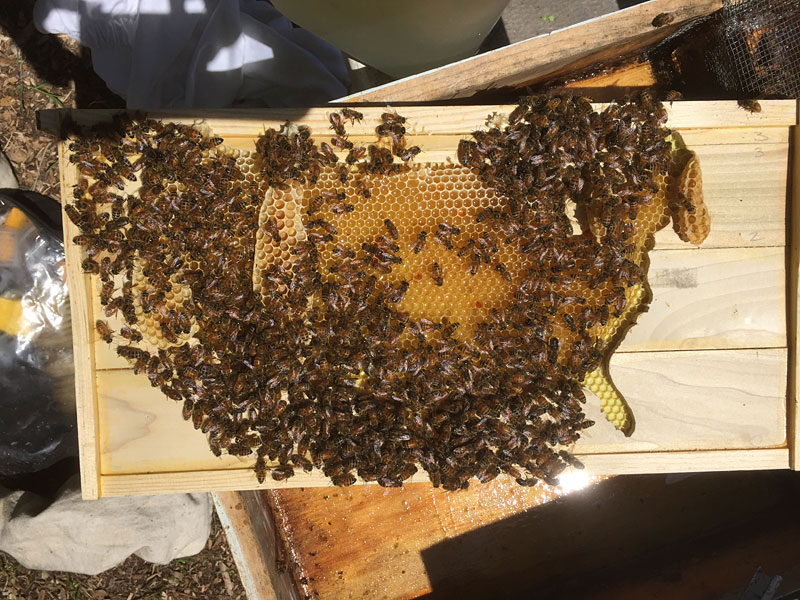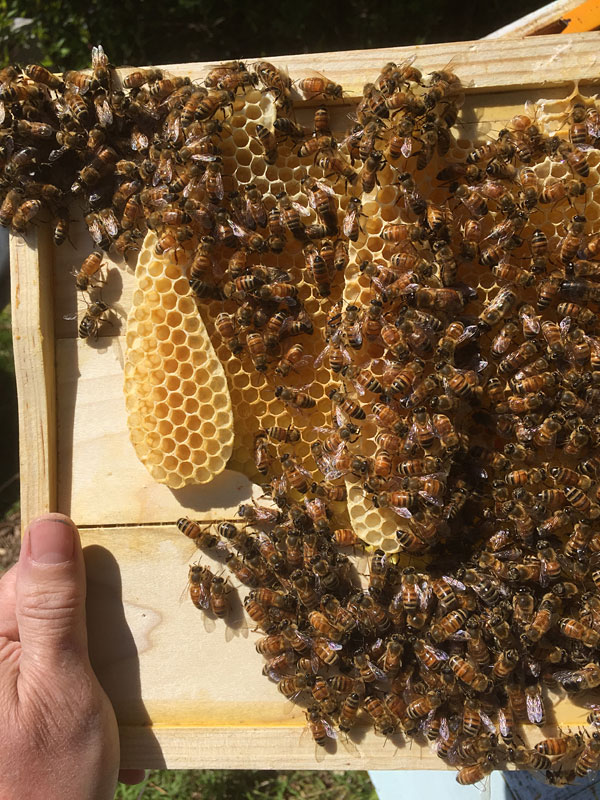I've recently started an experiment with my bees that involves a wood frame and wax foundation in the shape of the United States (lower 48). In two weeks, they've made a lot of progress and show a knack for US geography without any prompting on my part. California and the Pacific NW are extremely popular and apparently too small, as the bees have built burr comb to make the west coast bigger. They have built-up the Rocky Mountains as the high point of their map; and constructed a very large island off the coast of the Northeast. Perhaps an enlargement of overcrowded Manhattan? Otherwise, there's not much happening on the East coast. They've made some progress on the northern section of the Appalachian mountains, maybe a Catskills retreat for Manhattan bees to get away. Florida gets zero attention because the peninsula is too small for bees to make it worth their effort. The Southeast, Midwest and Texas are basically flat but above sea level (if you imagine the wood frame to be their ocean). Nearly all of the nectar and pollen are stored in the bread basket of our nation. Good job little geography bees!
open studio: pollination USA /
Pollination (USA), 2015. 1st in a series by artist and beekeeper Kelly Heaton. April 20, 2015
This video documents a wax-coated frame in the shape of a US map (lower 48) as it evolves within a beehive. I shake the frame to disturb the bees and observe how they move in response. No bees were harmed in the making of this video. To the contrary, I do everything I can to keep my bees alive and healthy. My package bees were installed a week ago and have since drawn some comb on the frame which is filled with nectar. These areas are darker in color and the nectar is reflecting the sunlight.
pollination: meet the new queen /
See into a young beehive. This video was shot with an inspector's videoscope, so the frame rate is low and makes it look choppy. Nonetheless, the videoscope allowed me to record activity inside of one of my new hives - and by chance, I caught footage of their new queen only two days after installation from a package that shipped in from Georgia. You can recognize her because her abdomen is larger, more of a pale yellow and her wings are set out to the side instead of folded onto her back. My apologies that she is not marked, this would make it much easier to recognize her ... and I need to take care of this before the hive population increases. Notice areas in which the honeycomb is shallow and others where it is fully formed. This is because I gave the bees some frames with new foundation mixed with frames that already had drawn comb with honey. If possible, I try to feed my bees with honey instead of sugar water because it's better for them; and I have many frames with honey from my hives that sadly died in late winter of this year.
Below are images from the package installation, two days before this video was taken.
Photos by Sarah Loy, 2015.
pollinators: bees licking honey /
Happy day! My bees arrived after their long road trip from Georgia to Virginia. Because it's raining and bees dislike dampness, I will install them tomorrow when the weather is dry. Plus it's fun to keep them overnight in my studio and get to know them. This video shows them lick honey that I smeared onto the outside of the packages. Packaged bees are shipped with sugar water to feed them in transit, but they much prefer honey -- as this video shows.
open studio: building the throat chakra /
The Beekeeper is a large sculptural work-in-progress, to be exhibited as part of Pollination in September 2015. It is comprised of seven or eight chakras. Here, I am building the throat chakra out of brass. In the center (4th image) is a low RPM / high-torque motor that turns the throat, pineal and heart chakras. The pineal and heart chakras are not shown in these images, but will be featured in later posts.
perfume: scent and synesthesia /
For my upcoming show, Pollination, I am working on a series of conceptual perfumes that relate to artworks in non-fragrant media. Here are some images of my perfumer's bench; and part of a sculpture that artfully invaded my desk for a time.
What intrigues me about fragrance? Where to begin. Smell is our most ancient sense, touching our memory to the core.
Why would a visual artist learn to make perfume? Scent, color, kinetics, sound, taste, visions, touch: these are all various experiences of waveforms. Humans only have so many tools to perceive and therefore understand the world; I intend to explore all of them because what I care most about are the waveforms, the jiggling energies beyond our mortal veil of senses. The more ways in which I can experience a priori signals, the closer I feel to the truth of their nature.
Not to mention, how could any body of work on the topic of pollination avoid fragrance? I would surely be stung in retribution.
I will also add that perfumery, watercolor painting and cooking all extremely similar in my experience. I understand why perfumer and author Mandy Aftel puts essential oils in her food: I find it increasingly difficult to distinguish one sense from another. The closest relationships are smell, taste and color. Line and texture map to rough, gritty or other textural scents, but color is my predominant synesthetic experience of fragrance and taste. And vice versa: color has scent and flavor. By comparison, my experience of electrical engineering is most closely represented in sound and movement. Electronics are more like dynamic line drawings of immense complexity.
open studio: gut chakra, flora and fauna /
Detail of The Beekeeper, 2013 - 2015
For my upcoming show Pollination (September 2015), I am working on a large sculpture called "The Beekeeper." Energy nodes (aka chakras) of the human body are represented therein. This image shows a detail of The Beekeeper's gut chakra, comprised of hybrid plant and insect electronics on the traditional green circuit board, or ground plane. I experience the gut chakra as distinct from the solar plexus, an opinion that I mention because most people consider them one and the same. I usually see the gut chakra as indigo blue; but here, yellow light from The Beekeeper's bright solar plexus causes the blue to show up green. More on that later. Kelly Heaton, 2013 - 2015
open studio: giant transistor with dog in winter landscape /
This 6 foot tall steel rendering of an NPN transistor is a work-in-progress for a sculpture titled "Colony Collapse Disorder," premiering September 12th at Ronald Feldman Fine Arts as part of my Pollination show. The snow and dog are irrelevant save for: packed snow was a convenient medium to make the transistor stand upright for the photo and my old dog, Spivey, provides a sense of scale. For those electronics geeks among you, yes, the NPN transistor is raising its leg to become a diode. Spivey doesn't raise her leg because she is a girl.























